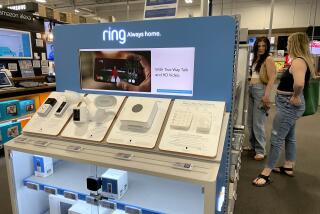007 Comes Home
- Share via
When Dad bought Grandma an automatic dishwasher 35 years ago, she chortled. Who would use a machine to wash dishes? And an electric can opener? A garage door opener? Get outta here. But when her well-used dishwasher failed a few years later during a family feast, Grandma nearly wept.
Oh, how we humans evolve. But with a century of innovation behind us, we still resist running headlong into the automated ambience of James Bond and the Jetsons. Rather than embracing aluminum counters and plastic furniture, we seek more often to make our homes feel old-fashioned, with hardwood floors, thick pillars, sturdy moldings, paned windows and wood-look exterior shingles. Eight months from the next millennium, home technology still seems futuristic.
Our problem: The promise of easy, high-tech living has arrived at our door burdened with codes, little buttons, switches and complex wall panels (one for heating, one for lighting, another for sound) that none of us can decipher.
“When James Bond walks up to a door, it opens. You don’t see a bunch of wall panels,” says David Epstein, 40, whose Santa Monica company, Sound Solutions, outfits homes with high-tech systems and gadgets that regular people can operate. “We need to make our systems easier to use than ATM machines.”
Ironically, it is technology that will make technology doable. Specifically, by linking our home computers to complex home security, lighting, heating, home theater and sound systems (allowing point-and-click, drag-and-drop ease), we can finally enjoy “smart” homes where the drapes close when the direct sun beats in, the skylights shut when it rains, and the lights come on when the burglar alarm goes off.
For homes without computers, touch screens simplify once-incomprehensible programming for home systems. Want to schedule the lights to come on at dusk? Touch the lighting icon on the screen and be led through the procedure. Same with scheduling your sprinklers to come on when the lawn sensor signals dryness, or for your home furnace to crank down at night. (Until now, it’s estimated that fewer than two out of 10 homeowners with programmable thermostats have ever used them.)
To help homeowners embrace computer-programmable home systems, IBM is heavily marketing its Home Director Kit, which comes in two versions: one to retrofit your already existing home (complete with a CD-ROM), the other is available to new-home builders and involves the installation of high-speed phone lines that connect to your home computer.
Other forward-thinking home contraptions include refrigerators and dishwashers disguised in drawers, recipes on your PC with hot links for turning on the oven, caller ID displayed on your television so you don’t have to get up to see whose call you don’t want to take, weather information downloaded from the Internet that integrates with your home heating and cooling controls, and dishwashers that will request their own service via the Internet.
With some of these inventions already available and numerous others on the way, perhaps the real question is: Do we really need all this stuff?
“Do you need your remote control?” asks Ken Kerr, president of the Home Automation Assn. and owner of Home Controls, in San Diego. “Would you give it to me and get up off your butt to change the channel? Would you give me your garage door opener? . . . The only way [we’re] gonna get it away from you is to pry it out of your cold, dead fingers.”
For information: Sound Solutions: (310) 393-5332; IBM: (800) 426-7144; Home Controls: (619) 693-8887; Home Automation Assn.: https://www.homeautomation.org.
More to Read
Sign up for Essential California
The most important California stories and recommendations in your inbox every morning.
You may occasionally receive promotional content from the Los Angeles Times.






